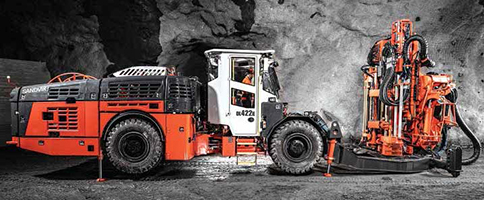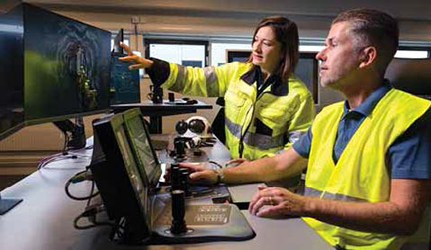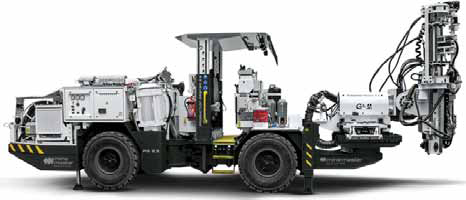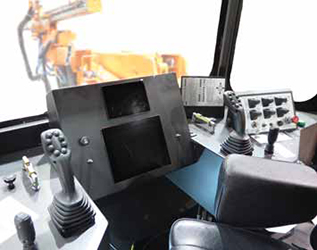
The Simba E7 at work underground. (Photo: Epiroc)
Advancing Art of Autonomous Drilling
We review the latest in autonomous features for underground production drill rigs
and asks four companies, what’s next?
By Carly Leonida, European Editor

Faster, more reliable communication and data transfer technologies are at the heart of this revolution. And, as the latest generation of LTE and 5G networks become more widespread, the next five years will see a greater choice of systems and capabilities come to market for both new and existing rigs, as well as increased uptake. To get a feel for what’s available and what’s coming, E&MJ spoke to four OEMs.
Epiroc Releases RCS
Version 5
Epiroc offers a range of rigs for production
drilling, including those with battery-electric
drivelines — the M and E series of mid- and
large-sized Simba long-hole drill rigs are
part of Epiroc’s latest generation of BEVs —
as well as advanced control systems.
The company recently transitioned
its Rig Control System (RCS) automation
platform, originally in 1998, to version
five for underground production drilling.
Guilherme Paiva, global automation
lead with Epiroc’s Underground division,
said the latest version offers benefits in
multiple applications. Highlights include
more user-friendly GUI and operator assistance;
a Linux operating system for
more capacity and use of a wider range of
software suppliers; teleoperation of up to
12 machines; and the use of four or more
control panels.
“Safety is always Epiroc’s top priority and a key concern for mining companies. Thanks to new technology and automated capabilities, operators can be removed from hazardous zones and can work more like a supervisor thanks to more intelligence and monitoring functions — this is a key factor for differentiation,” Paiva said. “Higher asset utilization with the possibility to operate through shift changes is also relevant for all mining companies. Digitalization and the ability to use data and information from different systems for superior planning and decision making also adds value to operations.”
The smart and seamless integration of technology, processes and people offer multiple opportunities to handle data faster and in a more reliable manner from planning to execution and reporting. This enables a more holistic approach in underground drilling applications and superior decision making. “What we have seen over the past few years is that domain knowledge in the core activity together with digital technologies gives a huge push in optimizing potential,” Paiva explained. “In brief, you can say that gathering information and making it available in the right way paves the way both for better decision making and more automated processes. There are great opportunities to improve both productivity and accuracy in drilling, and it’s important to do so with a goal in mind.
“Experience tells us that as soon as a problem or opportunity has been identified, you will need information to first understand where you are today, to set the goal, and to move toward that goal. Accuracy will be important in this context, and digital technologies help to increase information quality and to automate the information flow. Just by starting to collect information in a structured way, digital tools help to visualize uncertainties, show gaps in information, highlight problems, and also indicate needs for other data sources.”
Mines Utilize 6th Sense
The 6th Sense program is Epiroc’s way of
optimizing customer value chains through automation, system integration and information
management. The underground
offering comprises the Insight, Control
and Optimize product families. Insight
includes solutions for collecting, transferring,
storing, visualizing and analyzing
data, transforming it into useful information
for data-based decision making. Control
combines different features, functions
and product packages to improve
process and machine control in a safe,
consistent and reliable manner. And Optimize
offers services and products that
support process optimization.

Lundin Mining’s Zinkgruvan mine Sweden recently became the first operation to teleremote control its production rigs through an LTE network, and Paiva hinted there are more exciting projects soon to be announced. “Most of our latest projects involve teleremote advancements, and innovative technology like LTE-enabled Simba rigs,” he said. “Apatit, part of Phos- Agro Russia, owns the world’s largest teleremote fleet of production drill rigs — around 17 in total — and more machines and control room options are being added.”
Apatit has seen a dramatic increase in productivity and improved operator safety since introducing Epiroc’s 6th Sense program in 2018. The company’s sub-level caving operation in Russia has seen a 20% utilization increase and an average 92% availability in its rigs through adding Simba Automation and a teleremote-control room. “Epiroc is always searching for solutions toward creating autonomous mining operations in real time,” Paiva said. “There are great opportunities for superior use of data to enable a more holistic approach track-asset performance in underground applications.”
Sandvik Targets Superior
Accuracy
Sandvik has also been working on its
range of intelligent solutions for long-hole
rigs and rock drills.
Equipped with fan automation and
teleremote drilling functions, the first
Sandvik automated top hammer long-hole
drills were delivered 25 years ago. For the
last five years, the majority of its delivered
units have been automated, while the use
and full utilization of these features — including
boom movements between holes,
alignment, rod handling and data management
— has begun to increase.
“Our long-hole drills feature the latest in intelligent technology to ensure continuous and unmanned operation, with automation and teleremote operation for drilling during breaks and shifts changes,” said product manager, Jukka Naapuri, from Sandvik Mining & Rock Technology’s Underground division. “As regulations become stricter with a corresponding demand for cleaner energy, Sandvik’s drilling solutions specifi- cally address the challenge of providing enhanced performance combined with low emissions. Today, mining companies are aiming for more sustainable operations, they are looking for new technology in drilling automation, data management, and teleremote operation, removing workers from hazardous environments to improve safety and productivity.”
Through different automation packages, Sandvik’s long-hole drill offering can provide continuous and unmanned operation in underground mining through shift changes and breaks, utilizing data up and downloads through wireless networks. Teleremote user interfacing where one operator can supervise multiple drill units is also available. “Automation in drilling can only fully be utilized for productivity increases if all the phases in the cycle can be automated, including features such as bit changing and collar pipe handling,” Naapuri said. “Discussion on multi-fan automation has also started, where the unit would be moved manually in teleremote mode or automatically between the fans; for this, the drill would need to know its position in the drift and in the mine so that carrier navigation can be carried out accurately and safely.
“However, today, the focus is still on completing one fan or drilling plan automatically, including drilling, rod handling, bit changing, hole alignment and boom movements between the holes; drill plans are wirelessly transferred to the drill and the ‘as-drilled’ data sent back to the office. Mines would like to ensure that holes in their stopes are drilled accurately according to the plans, and that as-drilled data is available for planning explosives charging and blasting, as well as further mine planning.”
Accuracy is a function of the measures implemented, as well as the drill and operator’s abilities. The following factors are important to consider: • Drilling equipment that fulfills the requirements of the mining method and drill plans; • The use of large-size rock tools compared to the hole diameter drilled; • Correct alignment of holes and good drill stability during drilling; • Drilling parameter settings, which are optimized to hole and rock conditions; and • Implementing drill operator KPIs based on accuracy rather than meters.
“Hole alignment is a key element in controlling accuracy,” Naapuri explained. “Most long-hole drills utilize laser pointbased carrier positioning at the fans, after which one of the fan pivot points (position in the drift) is shown to the unit (by moving the boom rotation center to the position). Sandvik’s Drill Plan Visualizer can be used in creating drill plans suitable for upload on the drill’s control system, and in retrieving the as-drilled data back for reporting and visualization.”
To have each hole aligned within the specified system accurately and on the correct collaring point requires careful use of instruments, a well-maintained machine and a drill operator who is motivated to align all holes accurately. Over the past two years, Sandvik has helped Mineraçăo Caraíba’s Pilar mine in Bahia, Brazil, switch from using in-thehole to top hammer drilling techniques. The aim was to boost production and safety while lowering mine infrastructure costs. Sandvik supplied a DL421 fan drill as well as a team of experts to support the tests.
The DL421 includes onboard features such as Full Fan Automation, which automates the drill pattern; Bit Changer, for automatic bit change, avoiding loss of time and handling risks; and Data Transfer, which automatically launches data for all holes drilled. Two months were dedicated to commissioning and monitoring. This included support for hiring operators, who needed to have specific skills, staff training and process definition. The project ran smoothly and the mine achieved an increase in slot yield, a reduction in stope drilling times, and a subsequent increase in the sufficiency index of drilled ore.
Combining Automation With
Battery Electric
Naapuri explained: “Capitalizing on
our experience and knowledge of battery
technology, we are also introducing
two new fully electric drills this year:
the DL422iE long-hole drill, which was
launched in early March, to be followed
by a battery-powered rock bolter.”
The zero-emission DL422iE joins
the DD422iE as Sandvik’s second battery-
driven underground drill. The unit is
designed for underground mass mining
in 4 x 4 m or larger production drifts. It
features the latest intelligent technology
to enable continuous and unmanned operation,
with automation and teleremote capabilities
for drilling during shift changes
and breaks and is capable of drilling vertical and inclined fans and single or parallel 89-127-mm-long holes up to 54 m in
depth using ST58 and ST68 tube rods.

While the battery-powered version of this rig, the DL422iE, went through site acceptance testing in Canada last year and was launched in March, the diesel-powered version is still to follow. The DL422i will make its debut later this year. This is a fully mechanized and compact electrohydraulic top hammer longhole drill equipped with a 33kW HF1560ST long-hole rock drill.
Naapuri said that, with an impact frequency of 40-45 Hz and optimized percussion dynamics for ST68 tubes, the DL422i delivers optimal bit-to-rock contact for improved energy transfer. The DL422i is equipped with telescopic boom and horseshoe-type boom support with telescopic jacks for maximum drilling stability. An optional extended boom support increases versatility in down-hole drilling in stopes at the end of the orebody, in drilling long holes in the ore/waste contact and in slot raise drilling.
Mine Master: New Rig in the
Pipeline
Mine Master, part of the GHH Group, is
currently designing an automatic underground
production rig with three levels
of automation. The company’s standard
production drill rig, the Production Master
(PM) 2.3, is a self-propelled long-hole
drill rig designed for drilling parallel up
holes and down holes as well as fans and
rings in vertical or inclined planes.

A battery-electric version of the PM 2.3A will also soon be available. This is built on the same chassis as Mine Master’s new battery-electric Face Master 1.7LE and Roof Master 1.8KE drill rigs. Both machines are currently being tested in KGHM copper mines in Poland. Mine Master’s sales director, Witold Hnat, spoke about the significance of maintaining low-cost, high productivity and high availability of equipment along with reducing the number of personnel underground. “Particularly during this pandemic, mine sites are dealing with a shortage of staff due to health problems or quarantine,” he said. “Additionally, mines need to address growing issues related to the limited number of experienced drill operators available, therefore, they are searching for solutions that can help to eliminate most of the tasks that would require an operator on site. They see the benefits of automation from a safety point of view and also shortage of manpower point of view.”
Hnat acknowledged that LTE and, specifically, 5G technology has been a driving force behind the development of automated capabilities for underground production drill rigs. As the telecommunications sector adapts its offering to specific industry needs, the opportunity to add more value arises. “We are really looking forward to the positive results of using 5G technology in mining operations,” Hnat said. “It will help to overcome the current issues with connectivity and undisturbed data transfer, which is crucial in automated drilling.” To help mines increase the efficiency and effectiveness of their drilling activities, Mine Master has developed an Automatic Drilling System. Once the machine is set up, a fully automated ADS system allows the machine to drill the face without the intervention of an operator. The system is able to adjust the drilling pattern to a wide range of faces and select the most suitable one.
J.H. Fletcher’s Graphic Angle Operator Display
J.H. Fletcher & Co. offers a complete line of drill jumbos. The
company is working toward automated processes for its production
drill rigs but, as all operations have different requirements,
it’s taking a broad approach.
The Fletchbus system is optional for all jumbo models. The system
works as a smart hub for machine operations and data collection.
It allows customers to receive more interlock features, safety
features, diagnostics, flexibility and an increase in performance.
The Graphic Operator Angle Display (GOAD) is incorporated
into Fletchbus. GOAD utilizes sensors on the boom and feed
mechanisms that display hole angles and depth of drilling on an
in-cab monitor. The system automatically controls the drilling
and adjusts the parameters for different strata and drilling conditions.

On-screen help and diagnostics assistance are also included. GOAD’s top tier includes Automated Entry Detection (AED). This system expands on the MPA system, utilizing its hardware paired with LiDAR scanning and point cloud technology to facilitate automatic drill entry. With this system, the machine will be able to perform spatial recognition by referencing surveying marks. The machine will then orient the drill pattern in such a way to maintain the entry along the predetermined direction indicated in the mine plan.